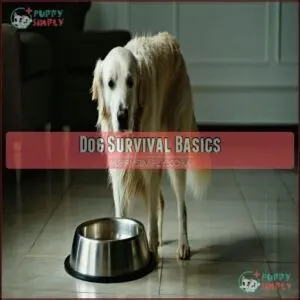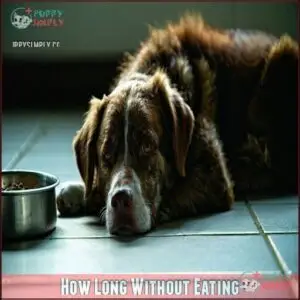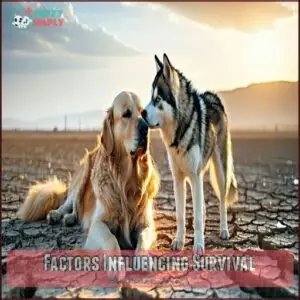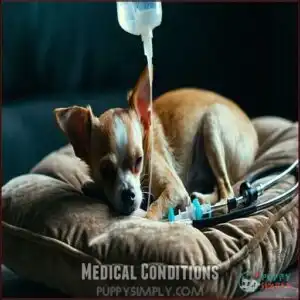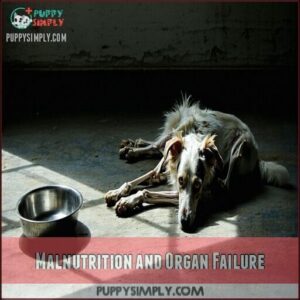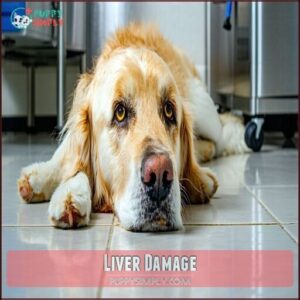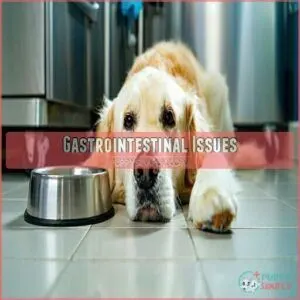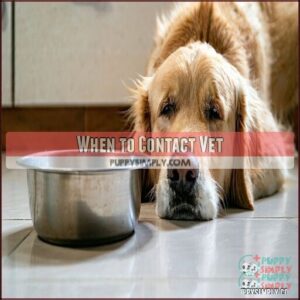This site is supported by our readers. We may earn a commission, at no cost to you, if you purchase through links.
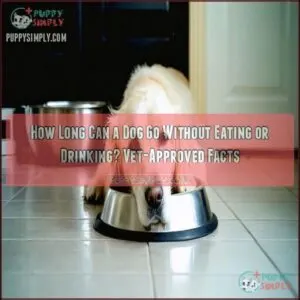 Dogs can usually go up to 5 days without food but only around 2-3 days without water.
Dogs can usually go up to 5 days without food but only around 2-3 days without water.
Water is essential because dehydration sets in fast and can lead to serious health issues like organ failure. Things like age, size, and health status play a big role in how long they can manage.
If your dog skips a meal or two but still drinks, it might not be a huge deal, but call the vet if they stop eating or drinking entirely. Always keep an eye out for signs like lethargy, dry gums, or vomiting—those could mean trouble brewing.
Every pup’s different!
Table Of Contents
- Key Takeaways
- Dog Survival Basics
- How Long Without Eating
- Water Importance
- Factors Influencing Survival
- Causes of Loss Appetite
- Seeking Veterinary Care
- Encouraging Eating Habits
- When to Contact Vet
- Frequently Asked Questions (FAQs)
- What happens if a dog doesn’t eat or drink for 2 days?
- How long can a dog go without eating or drinking?
- How long can a dog go without food and water?
- How long can a dog survive without food?
- Can a dog go a day without eating?
- How long can a dog survive without water?
- Can a dog go without water?
- How long can a dog go without eating?
- How long can a dog live if he doesn’t eat?
- How long can a dog go without water?
- Conclusion
Key Takeaways
- Dogs can go up to 5 days without food, but only about 2-3 days without water before dehydration sets in.
- Water is more critical than food since dehydration can cause organ damage within 24-72 hours.
- If your dog hasn’t eaten or drunk water for 24 hours, contact a vet immediately to prevent serious health risks.
- Watch for warning signs like lethargy, dry gums, sunken eyes, or thick saliva, and act quickly if you notice them.
Dog Survival Basics
Food and water are essential for your dog’s survival, affecting their energy, organs, and overall health.
Food and water fuel your dog’s vitality, ensuring energy, healthy organs, and a thriving spirit every single day.
Understanding how long they can go without these basics helps you act quickly to keep them safe.
Importance of Food and Water
Food and water are essential for keeping your dog’s body functions running smoothly.
Nutrient essentials fuel energy and repair, while hydration benefits support temperature regulation and circulation.
Without them, sustaining life becomes impossible. A dog without food or water faces risks like dog dehydration, weakness, and a dip in vitality.
Guarantee access to:
- Fresh water daily
- Balanced meals
- Proper feeding schedules
- Vet checkups to prevent issues like dehydration and ensure overall health.
Effects of Prolonged Fasting
When a dog goes without food for days, its body undergoes metabolic changes, breaking down fat for energy.
Without food, a dog’s body shifts to burning fat for energy, but prolonged fasting leads to muscle breakdown and serious health risks.
Over time, energy depletion leads to muscle breakdown and nutrient deficiencies, which stress essential organs.
Prolonged fasting causes irreversible organ damage.
A canine starving without water faces dehydration even faster, making recovery harder.
Always monitor closely to avoid serious health risks.
Healthy dogs can endure up to five days without food before facing organ damage.
Risks of Dehydration
Without enough water, dehydration in dogs sets in quickly.
Thick saliva, sunken eyes, and reduced elasticity in their skin are common signs.
Without hydration, organ damage and electrolyte imbalance worsen.
Dog health deterioration starts within 24 hours of water deprivation.
If your dog’s not drinking, it’s critical to act fast—dehydration can lead to irreversible harm or even death.
How Long Without Eating
Every dog has its limits, and skipping meals can be risky. Healthy adult dogs can survive 3-7 days without food, but it’s far from ideal.
Food refusal isn’t just about hunger; prolonged dog food deprivation leads to energy drops, muscle breakdown, and potential organ damage. Puppies, senior dogs, or sick pets face higher risks and shouldn’t go over 24-48 hours without eating.
Signs a dog isn’t eating might include:
- Lethargy from fasting risks
- Weight loss and weakness
- Loss of interest in food
- Signs of distress or discomfort
- Visible muscle breakdown
If your dog hasn’t eaten for 2 days or seems unwell, act fast. Contact a vet to figure out why and prevent complications from prolonged food refusal.
Water Importance
Water keeps your dog’s body functioning properly, from aiding digestion to preventing dehydration. Without it, serious health issues can develop quickly, sometimes within just 24 hours.
Dehydration Signs and Symptoms
Dehydration in dogs sneaks up quickly but shows clear signs.
Watch for a dry nose, sunken eyes, pasty saliva, or dark urine.
Reduced skin elasticity is another red flag—gently pinch their skin; if it doesn’t spring back, act fast.
A dog not drinking or showing these symptoms needs immediate rehydration before dehydration causes serious harm.
Always monitor hydration closely.
Encouraging Water Intake
If your pup’s drinking seems off, there are easy ways to encourage better hydration. Try adding Water Flavoring like low-sodium chicken broth.
Make certain Water Accessibility with clean bowls throughout your home. Experiment with Water Temperature—some dogs love cool water!
Use fun Hydration Methods like ice cubes or a pet fountain to boost your dog’s water intake naturally. Many owners improve hydration using a flowing water source.
- Add low-salt broth to water.
- Offer cool, fresh water frequently.
- Try a pet fountain for flowing water.
- Use ice cubes as a playful hydration hack.
Monitoring Hydration Levels
Check your dog’s skin elasticity by gently pinching their skin—it should snap back quickly.
Watch for dry gums, dark urine color, and sunken eyes, all signs of dehydration in dogs.
Increased panting frequency may also signal water deprivation.
Regularly monitor these cues to catch hydration issues early and guarantee dog rehydration with fresh water available at all times, ensuring proper hydration issues are addressed.
Factors Influencing Survival
A dog’s ability to survive without food or water depends on several factors like age, health, and access to water.
Younger dogs, senior dogs, and those with medical issues are more vulnerable to complications during fasting or dehydration.
Age and Vulnerability
Age and health play a big role in a dog’s survival without food or water.
Puppies and senior dogs are most at risk due to limited energy reserves. Smaller breeds face added challenges.
Watch closely for risks linked to size, breed, or underlying conditions.
Here are key factors:
- Puppy Vulnerability
- Senior Risks
- Breed Predisposition
- Underlying Conditions
Access to Water
Water availability plays a big role in how long a dog can survive without water.
Keep it fresh because cleanliness matters—dirty water isn’t appealing. Also, consider water temperature; lukewarm works best.
Bowl placement counts too. Easy access encourages drinking. Place multiple sources around, especially outdoors.
Dehydration in dogs progresses fast, so consistent hydration helps prevent dangerous dog water deprivation.
Health Status
A dog’s health status strongly affects survival without food or water.
Underlying conditions, breed predispositions, weight concerns, and immune system strength all influence how long a dog can survive.
Active dogs might deplete energy faster, while less active ones cope longer.
If your dog isn’t eating or drinking, closely monitor their symptoms—prompt action could make all the difference, as it is crucial for their overall health.
Causes of Loss Appetite
A dog’s loss of appetite can stem from medical, behavioral, or environmental factors.
Understanding the possible causes will help you take the right steps to address the issue and protect your pet’s health.
Medical Conditions
A dog not eating could signal an underlying illness like cancer, diabetes, or kidney disease.
These conditions can lead to organ failure or severe dehydration.
Watch for:
- Vomiting or diarrhea worsening appetite.
- Signs of cancer symptoms, like unusual lumps.
- Diabetes impact, including lethargy or weakness.
- Toxicity concerns if your dog ingested something harmful.
- Rapid weight loss indicating a medical condition.
Chihuahuas are also prone to tracheal collapse issues, which can be a significant medical condition and may lead to severe dehydration.
Behavioral Issues
Stress, anxiety, or even disruptions in routine can lead to a dog not eating.
Separation anxiety or stress factors like loud noises or moving homes may suppress appetite. Picky eaters can resist certain foods, causing behavior changes.
Here’s a quick breakdown:
| Cause | Effect | Solution |
|---|---|---|
| Stress | Appetite loss | Anxiety reduction, routine |
| Routine changes | Eating disruption | Gradual adjustments |
| Anxiety | Refusal to eat | Calming techniques |
| Picky eating | Food aversion | Food variety, treats |
| Separation anxiety | Loss of appetite | Positive reinforcement |
Dental Issues and Oral Health
Mouth pain from tartar buildup, gum disease, or tooth decay can discourage your dog from eating.
Bad breath might hint at deeper dental problems causing appetite loss. If your dog skips meals, a dental cleaning may help.
Don’t delay addressing these issues—dental problems can worsen quickly. Ignoring symptoms like bad breath or appetite loss may leave your dog without proper nutrition or hydration.
Malnutrition and Organ Failure
Canine starvation can lead to irreversible damage, as the body breaks down fat, then muscle, to survive.
Without nutrients, dogs face organ shutdown and tissue damage, risking death.
Malnutrition and nutrient deficiencies cause:
- Weakness and lethargy
- Weight loss and frailty
- Organ damage in dogs, risking permanent failure
- Higher dog death risk without intervention
- Dehydration worsening organ failure
The combination of these factors can lead to a higher risk of death without proper intervention.
Liver Damage
Liver function is essential for your dog’s health.
When it’s impaired, toxin buildup occurs, leading to symptoms like jaundice signs—yellowing of gums or eyes.
Left untreated, it can result in organ damage in dogs or even dog organ failure.
If your dog’s not eating or has changed behavior, consult a vet immediately for treatment options and preventative measures.
Gastrointestinal Issues
Digestive troubles can stop your dog in its tracks.
Parasites, food allergies, or an imbalance in gut bacteria may cause a dog tummy upset or anorexia.
Watch for bloat risk, nausea, or signs of dehydration.
Digestive enzymes can help, but a dog not eating needs quick care.
If symptoms persist, consult your vet to address underlying issues.
Seeking Veterinary Care
If your dog hasn’t eaten or drunk in over 24 hours, it’s important to contact a veterinarian right away.
They can assess your dog’s condition, identify underlying issues, and recommend the best course of treatment.
Treatment Options and Recommendations
If your dog refuses food or water, start with hydration methods like broth or ice.
Try appetite stimulants, like warming up food or switching to a diet shift with softer meals.
Stick to consistent feeding schedules and consider behavioral therapy if stress is suspected.
Healthy dogs can endure a short period without food, but it’s vital to monitor them.
In severe cases, vet care may include IV fluids for the dog or emergency treatments, which can be crucial for their recovery, especially when they need consistent feeding schedules and behavioral therapy.
Consulting a Veterinarian
If your dog’s not eating or has gone without water for a day, a veterinary consultation is key.
Vets use diagnostic tests to identify underlying causes, whether it’s illness or stress.
Treatment options, from medication to supportive care, depend on findings, and virtual assessments can also help.
Don’t wait—emergency vets can save your pet’s life during urgent situations.
Monitoring Behavior and Health
Paying close attention to your dog’s behavior and health helps catch issues early.
Look for changes in energy levels, eating patterns, or hydration signs. Noticeable behavioral changes or physical symptoms like dry gums signal trouble.
If your dog’s not eating or seems off, act quickly. Here are three key checks:
- Daily water intake.
- Visible signs of dehydration.
- Sudden weight loss.
Monitoring these signs can help identify potential health issues, allowing for early intervention and a better chance of a positive outcome, especially in cases of sudden weight loss.
Encouraging Eating Habits
Encouraging your dog to eat can feel frustrating, but small changes can make a big difference.
Simple strategies like hand-feeding, warming up food, or offering appealing treats can help stimulate their appetite.
Hand-Feeding
Hand-feeding your dog can be a bonding experience, especially for picky eaters or during post-surgery feeding.
Use praise and encouragement to create positive associations. Gradually weaning them back to regular feeding works best. Avoid force feeding, as it may cause stress.
Here’s a guide:
| Scenario | Approach |
|---|---|
| Post-surgery feeding | Gentle hand-feeding |
| Dog anorexia signs | Stress-free patience |
| Appetite stimulation | Warm, aromatic foods |
| Picky eaters | Positive reinforcement |
Changing Food
Sometimes a fresh approach works wonders when your dog’s appetite falters.
Switching to new flavors or textures can make meals more appealing. For picky eaters or dogs with food sensitivities, try a gradual introduction of a new diet.
Exploring various dog food options might reveal a more palatable choice.
Start mixing small amounts of the new food into their regular meals. This way, their shift feels smooth, not overwhelming, and allows for a smooth transition.
Tempting With Treats
Switching foods didn’t work? Try mixing things up with treats. Use healthy treats or alternatives like plain boiled chicken or carrot sticks.
Timing matters—reward your dog when they show interest in eating. Keep portions small to avoid overfeeding, especially if they’re picky.
Offering a variety of treats can spark curiosity and help stimulate your dog’s appetite. You can find more information on wholesome dog biscuits.
When to Contact Vet
If your dog hasn’t eaten or drunk water for 24 hours, it’s imperative to act quickly and call your vet.
Waiting too long can lead to serious health issues, including dehydration or organ damage.
Signs of Distress
When your dog shows lethargy signs, appetite changes, or behavioral shifts, it’s time to act.
Dehydration symptoms like dry gums, sunken eyes, and thick saliva are red flags. Notice physical indicators, such as loss of energy or weight.
A dog without water or food for long risks severe weakness. Monitor for signs of starvation or dehydration immediately.
Breathing difficulties also require immediate attention. Stay attentive.
Vomiting or Lethargy
Spotting vomiting or lethargy in dogs can signal serious health issues.
These symptoms, tied to dehydration, illness, or toxicity, need urgent attention if combined with a dog not eating or drinking.
Signs to watch include:
- Repeated vomiting
- Unusual sluggishness (lethargy signs)
- Dry gums or sunken eyes (dehydration impact)
- Worsening symptom severity
Quickly contact your vet for immediate actions.
Weight Loss and Concerns
Weight loss in dogs, whether sudden or gradual, signals concern.
A Body Condition Score below normal suggests muscle mass loss, fat reserve depletion, or potential underlying conditions.
If your dog’s fasting continues, or you notice signs of starvation like muscle breakdown, reach out to your vet.
Changes in eating habits shouldn’t be ignored—they could mean serious health issues.
| Condition | Warning Signs | Concerns | Action Needed |
|---|---|---|---|
| Sudden Weight Loss | Rapid drop in weight | Starvation symptoms | Vet consultation needed |
| Gradual Weight Loss | Slow, consistent decline | Fat reserves depletion | Monitor closely, consult vet |
| Muscle Mass Loss | Noticeable muscle loss | Energy deficiency | Immediate vet evaluation |
| Body Condition Score Low | Visible ribs or spine | Underlying conditions | Seek vet care immediately |
Frequently Asked Questions (FAQs)
What happens if a dog doesn’t eat or drink for 2 days?
If your dog hasn’t eaten or drunk anything for 2 days, it’s serious.
Dehydration sets in quickly, risking organ damage.
Appetite loss for this long often signals illness.
Call your vet immediately for guidance and care.
How long can a dog go without eating or drinking?
Going without food or water is a serious gamble.
Dogs can survive 3-5 days without eating if they drink water, but dehydration is lethal after 72 hours.
Always make certain your dog stays hydrated and nourished.
How long can a dog go without food and water?
A healthy dog might survive 3 days without water and up to 5 days without food, but that’s risky.
Dehydration hits fast, often within 24 hours.
Always make certain your dog’s basic needs are met!
How long can a dog survive without food?
A dog can go three to five days without food, depending on its health.
Beyond that, they risk serious harm, like organ failure.
Always consult a vet if your dog skips meals for two days.
Can a dog go a day without eating?
Think of a dog like a car running on gas—missing one meal won’t stall it, but it’s not ideal.
A healthy dog can skip a day of eating, but don’t make it a habit.
How long can a dog survive without water?
A dog can survive around three days without water, but dehydration sets in much sooner.
After 24 hours, organ damage becomes a serious risk.
Always make certain fresh water is available to keep them healthy.
Can a dog go without water?
A dog can’t survive long without water.
Dehydration sets in within 24 hours, leading to organ damage.
Beyond 72 hours, it’s often fatal.
Make certain to have access to clean water to keep them safe and healthy.
How long can a dog go without eating?
Skipping meals isn’t ideal, but most dogs can survive 3-5 days without food if they’re drinking water.
Beyond that, their energy plummets, and health risks like organ damage and muscle loss start to creep in.
How long can a dog live if he doesn’t eat?
If your dog stops eating, it might survive around 5-7 days, but risks organ damage and other complications.
It’s essential to contact your vet if they haven’t eaten for more than two days.
How long can a dog go without water?
Without water, a dog usually lasts about three days.
After just 24 hours, dehydration can start causing organ damage.
Always encourage consistent drinking; use tricks like adding bone broth or ice cubes to water.
Conclusion
Just as water is the lifeline of a river, it’s essential for your dog’s survival too.
While food can be missed for a few days, water is non-negotiable.
Knowing how long a dog can go without eating or drinking helps you act quickly when needed.
Watch for warning signs like lethargy or dry gums, and don’t hesitate to contact your vet.
Every dog is unique, so stay attentive and proactive to keep your furry friend healthy.
- https://www.akc.org/expert-advice/health/warning-signs-dehydration-dogs/
- https://junovet.com/services/sick-patient-exams
- https://www.aspca.org/pet-care/dog-care/common-dog-behavior-issues/behavior-problems-older-dogs
- https://www.raisedrightpets.com/blog/how-long-can-a-dog-go-without-eating/
- https://petcube.com/blog/dogs-go-without-food-water/

